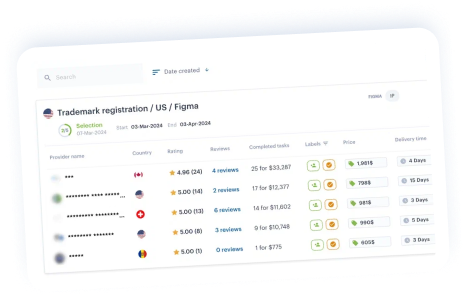Malaysia is a rapidly growing market with a strong economy offering vast business opportunities. The country’s GDP has consistently grown over the past few years, reaching a record of $370 billion in 2021.
With a growing number of businesses operating in the country, the demand for trademark protection has also increased. In 2021, the Intellectual Property Corporation of Malaysia (MyIPO) received over 50,000 trademark applications.
In this article, we will guide you through registering a trademark in Malaysia, including important information about trademark classification, the application steps, and documents required by Malaysian trademark law.
Contents
1. What can be registered as a trademark in Malaysia?
2. Why can you be refused to register a trademark in Malaysia?
3. The process of trademark registration in Malaysia
4. Documents required for the registration of a trademark in Malaysia
5. Trademark opposition process in Malaysia
6. Costs of trademark registration in Malaysia
1. What can be registered as a trademark in Malaysia?
In Malaysia, you can register a trademark for various goods and services. This includes products such as clothing, electronics, and food items, as well as services like consulting, education, and transportation. You can register the following types of trademarks in Malaysia:
- Words
- Logos
- Graphics, 3D
- Sound marks
- Color marks
- Holograms
- Scents
- Combined
When registering a trademark in Malaysia, it is essential to properly classify your goods and services based on the International Classification of Goods and Services. This will ensure that your trademark application is consistent with global standards and provides adequate protection for your brand.
You can also file a multi-class trademark application in Malaysia. This means you can use a single trademark to cover multiple classes of goods or services, provided they are all related. However, you will need to pay an extra fee for each additional class.
In Malaysia, you can also apply for temporary protection for a trademark shown at an international exhibition recognized by the government. This temporary protection does not add extra time to your priority rights, and if you claim priority later, it’ll still only be for 6 months from when the goods or services were first shown at the exhibition.
2. Why can you be refused to register a trademark in Malaysia?
Trademark registration in Malaysia may be rejected due to absolute and relative grounds. Absolute grounds are based on objective standards, while relative grounds consider the likelihood of confusion between the new trademark and an existing one.
For example, due to relative grounds, a mark will not be registered if it:
- is identical or similar to an earlier trademark or an application with earlier priority;
- is identical or similar to a well-known trademark that is not registered in Malaysia and is used for identical goods/services;
- identical or similar to a well-known trademark which is registered in Malaysia but used for different goods/services;
- identical or similar to a non-patentable name;
- identical or similar to an earlier design or design application with an earlier priority.
The following cannot be registered as trademarks in Malaysia due to absolute grounds:
- Marks that are misleading, against the law, or public interest and morality;
- Marks that are offensive or scandalous;
- Marks that might harm the nation’s interests or security;
- Marks that describe the type, quality, quantity, purpose, value, origin, or other features of goods or services;
- Common designations;
- Designations that are only based on the form of the goods or the technical result;
- Marks that only consist of a country’s name or recognized geographical indications;
- Marks that use someone else’s name without their permission;
- Marks that use the national flag, emblem, or royal coat of arms without permission from the appropriate authorities;
- Marks that use words like “Patent,” “Patented,” “Royal Patent,” “Registered,” “Registered Design,” “Copyright,” or similar words in any language
3. The process of trademark registration in Malaysia
The process of trademark registration includes a few steps, such as Malaysia trademark search, examination, opposition and issuance of certificate.
Before applying for trademark registration, it is recommended to search the Malaysia trademark database to determine if the desired mark is available. This can help avoid potential conflicts with existing trademarks and reduce the likelihood of the trademark being refused registration.
The next step is to file a trademark application with the Intellectual Property Corporation of Malaysia (MyIPO). The application must include the desired trademark, a description of the goods or services you will use it for, and the applicant’s contact information.
Once the trademark application is filed, it will be examined by MyIPO. The examination will determine if the trademark meets the requirements for registration, including distinctiveness and compliance with the Trademark Act.
If Malaysia Trademark Office approves the trademark, it will be published in the official gazette, allowing for a period of opposition. Any person who believes the trademark violates their rights can file an opposition within two months of the publication.
Once the opposition period has passed and there are no outstanding objections, MyIPO will register the trademark and issue a registration certificate. The trademark will then be protected for 10 years from the registration date and can be renewed for successive 10-year periods.
Overall, the trademark registration process in Malaysia typically takes up to 12 months and requires careful consideration of the requirements and potential obstacles along the way.
4. Documents required for registering a trademark in Malaysia
To register a trademark in Malaysia, you must file the following documents:
- A completed trademark application form.
- A clear representation of the trademark.
- A list of the goods and/or services for which the trademark will be used.
- A priority document (if claiming priority from a previous filing).
- Payment of the required fees.
In Malaysia, the official language for trademark applications is English. The convention and exhibition priority term are 6 months.
5. Trademark opposition process in Malaysia
In Malaysia, the trademark opposition process is a way for individuals or entities to challenge the registration of a trademark. That’s why it’s worth conducting a Malaysia trademark database search before applying.
The opposition process starts when an individual or entity files a notice of opposition with the Intellectual Property Corporation of Malaysia (MyIPO). Anyone can do this within two months of the publication of the trademark in the Trademarks Journal. Evidence and reasons for the opposition must support the notice of opposition.
The opposing party and the trademark owner then have the opportunity to submit their arguments and evidence. After considering the submissions, MyIPO may either dismiss the opposition or uphold it and refuse the trademark registration.
In case of a refusal, the trademark owner may appeal the decision to the High Court of Malaysia. The opposition process can be time-consuming and costly, but it provides a necessary mechanism for protecting the rights of parties who may be affected by the registration of a trademark.
6. Costs of trademark registration in Malaysia
Government fees of trademark registration in Malaysia:
| Application | |
| MYR 950 per class |
| MYR 1,100 per class |
| Trademark series | MYR 50 for the second and each subsequent trademark |
| Speedy examination | MYR 100 for each class |
| Certificate of registration | MYR 50 |
| Trademark renewal | |
| MYR 1,000 |
| MYR 1,200 |
| MYR 1,500 |
| License/sublicense | MYR 100 for each class |
| Bail | MYR 300 per trademark |
| Alienation | MYR 300 per trademark |
The trademark registration cost in Malaysia via the iPNOTE platform starts from as low as $480, which includes all government fees as well as document preparation. Find the best trademark agent in Malaysia on iPNOTE.
7. Final thoughts
Trademark registration in Malaysia is an important step for companies and individuals who want to protect their brand and intellectual property. It is essential to understand the trademark law in Malaysia, including requirements, processes, and potential grounds for a refusal to ensure a successful trademark registration.
***
The iPNOTE platform features more than 700 IP law firms that cover more than 150 countries, so you can always find the right direct service provider using our flexible filtering system.
Look at our directory of trademark attorneys in Malaysia.
Sign up for free, and we’ll help you solve any IP-related problem.
Unlock the full potential of your brand – register trademark in the Philippines and conduct a thorough trade mark search in the Philippines.






